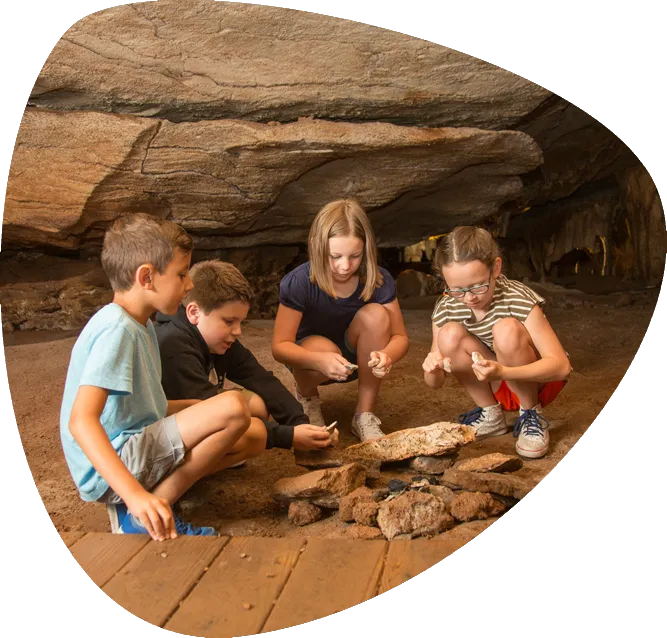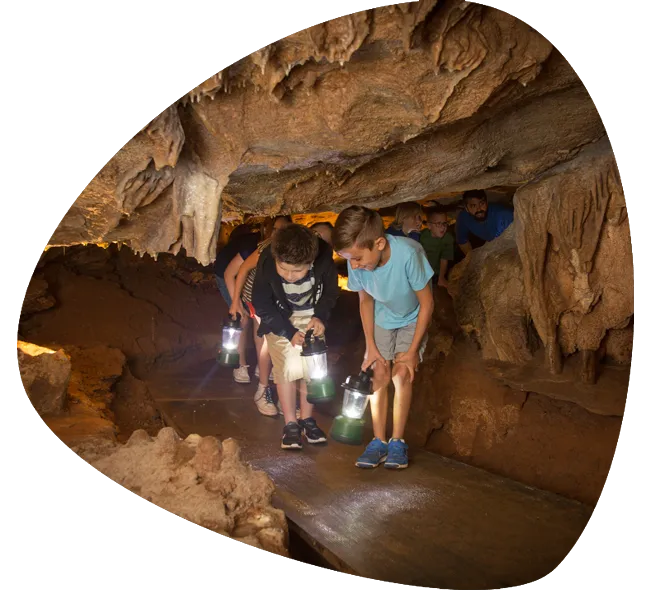The 5 E's
Cave Life Unit Pacing Guide
5E: Engagement
To gauge prior understanding and knowledge, ask students to describe what they know about plants and animals that are found inside a cave. In addition, ask if sunlight can make any difference in a cave. This may include a verbal presentation, written report, or drawing.
5E: Explore
Have students brainstorm about what they already know about plants and animals that live in a cave. Make an anchor chart listing and connecting all student input.
Are there some plants and animals the live near a caves entrance that aren't considered cave-dwellers?
What does sunlight do for cave life?
5E: Explain
Facts and Information - Cave Life
Cave Life
There is no natural light in caves. Without light, no green plants can grow. Algae, moss, and sometimes even ferns grow around in caves that have lights, but they can only grow there because of the artificial lighting.
So without green plants, what can grow in a cave?
Only things such as fungi and bacteria can grow in the dark interior of caves. They depend on organic matter rather than photosynthesis for food. Occasionally mushrooms grow on wood washed into caves, but bat guano will not support them. Mushrooms have been grown commercially in caves by hauling in livestock manure or other organics.
Fungus and bacteria are crucial to animal life in caves. Because there is no light to grow green plants for the animals to eat, the food chain is based upon detritus. Detritus consists of bat guano, cricket guano, sticks, leaves, and any dead organic material. However, most cave animals aren't able to digest this detritus...instead they eat bacteria and fungus that can consume the organic detritus. In addition, some cave animals are predators and eat other cave animals. Unlike other cave-dwellers, the bat is dependent on insects caught outside of the cave for its food.
Animals that spend their entire lives in caves are small, white, and blind. Even cave predators like the Ozarks cavefish, the cave crayfish, and the grotto salamander, are still only a few inches long. Other cave animals are even smaller and there are many different kinds that call Missouri caves home.
The Ozarks Cave Fish
Cave animals are so small and they are very few in numbers due to the lack of food inside caves. Most Missouri caves provide only 1/2000th of the food that is available on the surface. Even caves with large bat colonies, where their guano provides more food, a cave still only has about 1/200th of food found above-ground.
Why are cave animals white and blind?
Beyond the entrance area caves have no light, so animals living there have adapted. True cave-dwelling species lack skin pigment since they need neither sun protection nor camoulage. In addition, some animals (such as surface fish) with skin pigment will sometimes enter a cave. If they are unable to return to the surface they will become lighter in color because skin pigment needs sunlight to work.
The Ozarks Blind Crayfish
Like pigment, eyes have no value in the total darkness of a cave. In fact an animal with eyes might injure one...making eyes in a cave a liability. The lack of eyesight has caused other senses to be more keenly developed. The Ozarks cave fish, for example, has receptors along its head and body which pickup movement in the water.
Are bats blind too?
While bats have very sophisticated sonar... they are not blind. They use their echo-locations to find their favorite food, mosquitoes. To find them and other bugs, the bat emits a high-pitched sound and uses the echo to see its surroundings.
Every evening when the birds are perching for the night, the bats come in and take up the slack. Bats typically eat about half their body weight in bugs each night. They will return underground in the early morning hours and supply guano that is essential to the other animal life in the cave.
There are other myths about bats, most of which are untrue. Bats are not flying mice, nor closely related to rodents. Bats do not try to become tangled in women's hair. Not all bats are vampires; out of the world's species only 3 are vampire bats. Bats don't carry rabies, the can catch the disease like any other mammal, however they very rarely do.
The Tri-Colored Bat
While some caves have very large bat colonies, other caves have few if any bats that live inside them. A good example of a cave with a large bat colony would be Carlsbad Caverns, New Mexico...each summer evening you can set and watch as thousands of Brazilian Free-Tail bats emerge from the cave to spend the evening feeding. While on the other hand at Cave Science, Missouri there is a very small bat population. The Tri-Colored bat (formerly known as the Eastern Pipistrelle) that resides inside Cave Science is a solitary animal and you rarely see more than one while they are sleeping for the day or hibernating.
Endangered Species in Missouri Caves
A few threatened and endangered species call Missouri caves home...including snails, millipedes, crayfish and bats. One threatened species is found inside cave science. The Ozarks Cavefish can only be found in a few western Ozarks caves and there is estimated to be fewer than 500 in existence. Underground water contamination is thought to be their biggest threat.
White Nose Syndrome
WNS is a bat-born disease that has had a major impact on bat populations in the United States. Many caves in the northeast and upper midwest have seen their bat populations decimated by this disease, which is almost always fatal. Studies have shown that the disease causing spores are moved from cave to cave by bats. There is some concern that wild-cave explorers can transport the spores if they "crawl" in an infected cave, then visit another cave wearing the same, unwashed clothing. While this is only suspect, many states have choose to close wild caves that are located on public lands.
5E: Expand
Divide students into two groups to complete the Cave Life...Living in the Dark activity.
5E: Evaluate
Protecting Cave Country Study Questions
1. There is no _______________ light in caves. Without it, no ________ __________ can grow.
2. Only ___________ plants grow in the dark interior of caves.
3. __________ and ___________ are crucially important to animal life in caves.
4. Bat guano, sticks, leaves, and other dead organic materials are all examples of ______________.
5. Animals that spend their entire lives inside a cave are _________, __________, and ________.
6. At least _________ kinds of bats inhabit Missouri Caves.
7. Bats use _______________ to see their surroundings.
8. Bats usually eat _________ their body weight in bugs each evening.
9. Four species of bats are ___________________ in Missouri.
10. The Ozarks _______________ is a threatened species...there are fewer than ________ known to exist.

